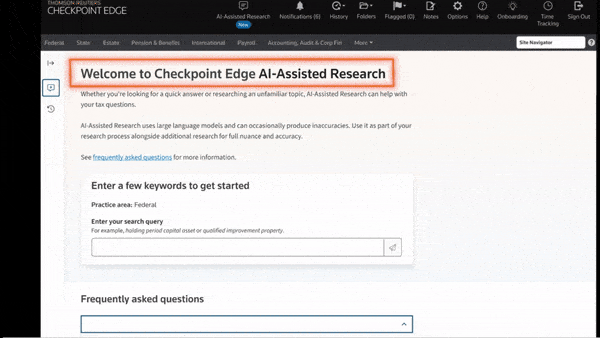You’ve found the ideal AI-powered tax and accounting research solution. With features like a professional-grade GenAI assistant and cited summaries that are quickly synthesized from trusted and authoritative content, you’re certain that this solution will save you time while empowering all levels of staff to independently find trusted answers. But how do you build your business case for the investment?
Jump to ↓
| 1. Emphasize the need for an industry-specific GenAI tax research solution |
| 2. Highlight how GenAI tax research technology empowers staff |
| 3. Show how you can better serve clients with AI-powered tax research software |
| 4. Demonstrate a return on investment |
| 5. Utilize accounting and tax vendor resources to further support your case |
5 tips to help prepare your business case
While the benefits may be crystal clear to you, the real question is: how do you convince others that GenAI-powered tax research is needed? A good place to start is to gather all of the benefits the solution has to offer so you can effectively and clearly communicate them. This includes how AI-assisted tax research can help empower staff, drive efficiencies, and improve accuracy.
Preparation is critical, so we’ve outlined some helpful pointers to help you make your case.
1. Emphasize the need for an industry-specific GenAI tax research solution
As an accountant, having a trusted resource at your fingertips in today’s ever-changing regulatory environment is essential. While popular, turning to publicly available generative AI platforms that pull data from across the internet is not the answer. This is a risky, time-consuming practice that can lead to unverified answers, reputational damage, and tax penalties for your business or clients.
Furthermore, even if your staff relies on a trusted source like IRS.gov or a state website for information, it still presents inefficiencies because they must then apply that information to the specific situation their client is facing. Plus, guidance on these sites can sometimes be difficult to fully understand.
However, with an industry-specific, professional-grade, generative AI tax research assistant built specifically for tax and accounting professionals, your staff can get straightforward answers to even the most challenging questions – just as if they were speaking directly to a subject matter expert or trusted advisor.
Simply pose a question and you’ll quickly receive a relevant answer in everyday language, complete with citations from experts and primary sources. From there, you can efficiently gather and apply the information to your communications with clients or colleagues, significantly saving time.
2. Highlight how GenAI tax research technology empowers staff
The most time-consuming part of tax research today is the research initiation stage: getting started, figuring out which tax code sections to apply, and building foundational knowledge of a topic in order to formulate an effective answer for clients.
Further complicating this challenge is the fact that junior professionals are often not trained on how to properly conduct tax research and frequently struggle with how to come up with well-formed searches. Given the fast-paced and frequent changes in tax policy, traditional search methods may require more time than professionals have available to stay fully informed and up-to-date. And, amidst time constraints, even the most dedicated senior colleagues may struggle to find the time to offer guidance to junior staff.
However, a GenAI tax research assistant can serve as a virtual mentor, available 24/7 to answer questions, provide instant insights, and guide entry-level staff through complex tax scenarios.
How does it work? Just ask a question in everyday language and receive a professionally summarized answer with defensible citations that can easily be forwarded to a colleague or client.
This interaction helps junior staff gain practical knowledge and refine their understanding of tax principles. A simple process, but one that eliminates the need to interrupt senior colleagues or wait for their availability.
3. Show how you can better serve clients with AI-powered tax research software
Your clients want fast, accurate answers to their tax and accounting questions, and they expect you to know the answers. However, keeping pace with tax law changes and their complexity can be incredibly difficult. This is where having the proper AI-powered tax research tool can help you better serve clients and strengthen loyalty.
With the right research tool in place, your business can find trusted answers to client questions — fast. Being able to bridge the gap between interpreting tax law and reporting real-life client transactions significantly enhances your staff’s value as trusted advisors and elevates related revenue-generating opportunities.
Plus, demonstrating to clients that you are an expert on every tax scenario (whether you’re using the software to reinforce an answer you already know or researching new topics you haven’t encountered before) will make you a hero in the eyes of your clients.
If you offer clients higher-value advisory services, for instance, having robust tools and resources at your fingertips is imperative for expanding your knowledge base to grow your practice to support your clients.
4. Demonstrate a return on investment
To further demonstrate why an AI-enabled tax research tool is a must-have tool, think about how much money your business could save if it implemented the solution — the tool could quickly pay for itself.
Keep in mind that cost savings not only come in the form of improved research efficiencies and time savings but also in greater staff satisfaction and client retention.
Consider this: It has been reported that the average turnover cost of replacing just one employee ranges from one-third to two times their annual salary. On top of that, think of the negative impact turnover can have on company culture and employee morale.
Your business can better attract and retain staff by having technology in place that empowers them, improves their business acumen, and saves them time to focus on more rewarding, higher-margin work.
Losing staff (or clients) to a competitor who has robust tools and resources in place and can provide a higher level of service is also costly. Eroding loyalty not only impacts the bottom line but also your brand and reputation.
5. Utilize accounting and tax vendor resources to further support your case
Lastly, once you’ve outlined the benefits to be gained by investing in AI-powered tax research and the cost savings and efficiency it presents, you can further support your case by leveraging resources provided by the solutions provider.
This can be testimonials from others already using the product, or perhaps a free trial so you can show your boss a few specific use cases where you know they’ll find value.
Making the investment in AI-powered tax technology
Preparation is key when presenting a cost-benefit analysis of AI-powered tax research. Be sure to outline the benefits that will have the greatest impact on your business and its clients.
In the end, having the right tools and resources in place means a happier and more engaged staff, stronger and more sustainable client relationships, and ultimately, greater profitability.
 |
|
 |
|









